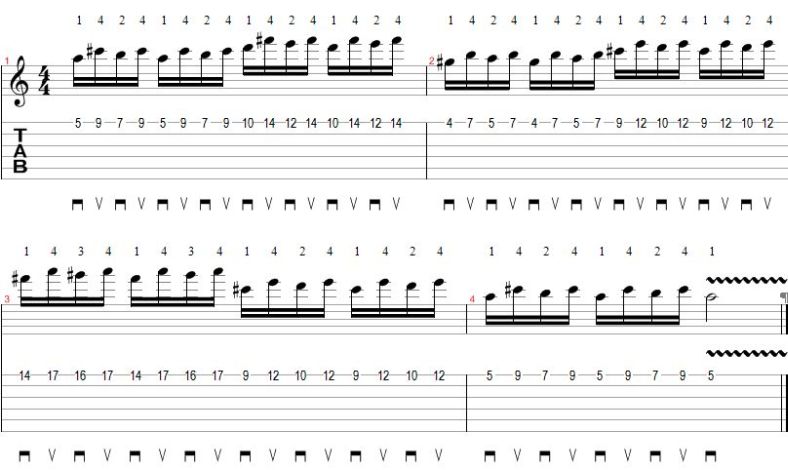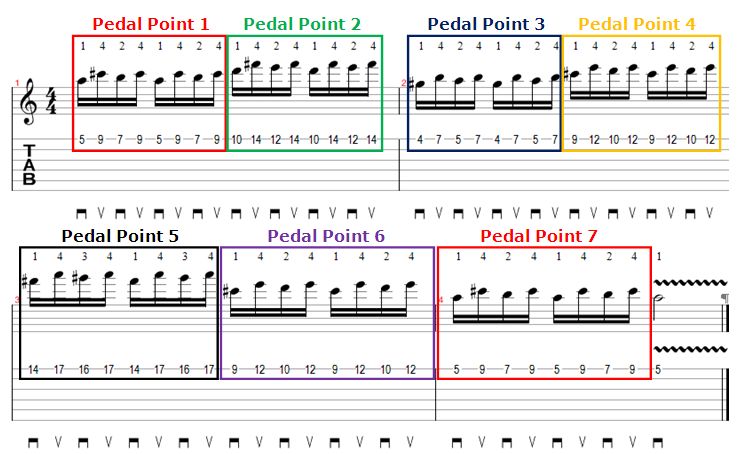How To Become A Great Neoclassical Guitarist - FREE 14 Day Neoclassical Guitar Lessons Mini Course - Part 2

Welcome to part 2 of my mini course on becoming a great neoclassical guitarist! By now you should be feeling a bit more comfortable with the pedal point lick I showed you in the last lesson. If you cannot yet play it at the speed it is played in the solo of the Labyrinth of Madness song, don’t worry about it. You will improve speed with this particular lick as your general speed increases over time.
Before we continue with learning another part of this song, I want to tell you a few more important things about the Pedal Point technique and also give you some tips for increasing your guitar speed.
Last time I showed you the Pedal Point idea using the Harmonic minor scale (the most common scale for neoclassical guitar playing). The truth is that the Pedal Point idea can be used with every scale. So you can achieve a large variety of sounds by applying the pedal point concept (which is repeating one note of a melody as the other notes are being played) to many different scales. This very important creative skill of taking one technique (such as pedal point for example) and applying it to a variety of different scales and contexts is one of the things I train my guitar students to do in my Neoclassical Revelation Guitar Course.
For your assignment in this lesson, I want you to take every scale that you know how to play and apply the pedal point idea to it (starting with the version of it that I showed you in the last lesson). This will be not only a great technique exercise for you, but also it will help you to review other scales you have learned in the past and will help you to come up with cooler sounding licks and phrases to use in your solos!
Here is an example of how to do this using the Major scale. Below is a tab of the A Major scale shown on one string.
Before we continue with learning another part of this song, I want to tell you a few more important things about the Pedal Point technique and also give you some tips for increasing your guitar speed.
Last time I showed you the Pedal Point idea using the Harmonic minor scale (the most common scale for neoclassical guitar playing). The truth is that the Pedal Point idea can be used with every scale. So you can achieve a large variety of sounds by applying the pedal point concept (which is repeating one note of a melody as the other notes are being played) to many different scales. This very important creative skill of taking one technique (such as pedal point for example) and applying it to a variety of different scales and contexts is one of the things I train my guitar students to do in my Neoclassical Revelation Guitar Course.
For your assignment in this lesson, I want you to take every scale that you know how to play and apply the pedal point idea to it (starting with the version of it that I showed you in the last lesson). This will be not only a great technique exercise for you, but also it will help you to review other scales you have learned in the past and will help you to come up with cooler sounding licks and phrases to use in your solos!
Here is an example of how to do this using the Major scale. Below is a tab of the A Major scale shown on one string.

We will use this scale to create a pedal point lick.
Remember that a pedal point occurs when one note in a melody is being emphasized (repeated) several times as other notes are being played. Here is one example of this that can be created from the Major scale, using the patterns you learned in Lesson 1. This pedal point sounds very similar to licks that you can hear in many of my Rhapsody of Fire solos!
Remember that a pedal point occurs when one note in a melody is being emphasized (repeated) several times as other notes are being played. Here is one example of this that can be created from the Major scale, using the patterns you learned in Lesson 1. This pedal point sounds very similar to licks that you can hear in many of my Rhapsody of Fire solos!

There are 2 pedal point fragments in each measure, and the pattern in the 4th measure is the same as it is in the first half of measure 1. Here is what the lick looks like with all of the pedal point fragments labeled.

The notes that are being used here come from the Major scale, but the pedal point patterns themselves are the same as what you learned in the last lesson of this mini course. You may want to review the lick I showed you in the previous lesson to compare it with the example from this lesson.
After practicing the above exercise, you can continue applying this pattern with other scales as well.
Now I want to share with you my special and unique way of picking fast. I used this technique to build my own guitar speed and it is also the same technique I use to train my guitar students. When I was learning to play guitar, all guitar players around me were using strict alternate picking to play guitar solos. As I practiced more, I noticed that sometimes in order to maintain the strict alternate picking pattern of down/up/down/up it would be necessary to skip over a string which resulted in extra motion.
I realized that this was not good and after some experimentation I started picking in a new way that really helped me to avoid this problem in many cases. Here is how I pick today:
Whenever I play something that is ascending, I always move to the next highest string with a downstroke.
Here is an example of this. You can see that whenever I change strings while playing this ascending scale, I play the first note of the next higher string with a downstroke.
After practicing the above exercise, you can continue applying this pattern with other scales as well.
Now I want to share with you my special and unique way of picking fast. I used this technique to build my own guitar speed and it is also the same technique I use to train my guitar students. When I was learning to play guitar, all guitar players around me were using strict alternate picking to play guitar solos. As I practiced more, I noticed that sometimes in order to maintain the strict alternate picking pattern of down/up/down/up it would be necessary to skip over a string which resulted in extra motion.
I realized that this was not good and after some experimentation I started picking in a new way that really helped me to avoid this problem in many cases. Here is how I pick today:
Whenever I play something that is ascending, I always move to the next highest string with a downstroke.
Here is an example of this. You can see that whenever I change strings while playing this ascending scale, I play the first note of the next higher string with a downstroke.
Ascending Scale

Whenever I play something that is descending, I always move to the next lowest string with an upstroke.
Here is an example of this. You can see that whenever I change strings while playing this descending scale, I play the first note of the next lower string with an upstroke.
Here is an example of this. You can see that whenever I change strings while playing this descending scale, I play the first note of the next lower string with an upstroke.
Descending Scale

Sometimes this would require me to play two downstrokes or two upstrokes in a row when changing strings.
Because I was now moving my hand much more efficiently, I dramatically increased my guitar playing speed after adopting this picking method. Now I play this way all the time. I encourage you to apply this approach to your lead guitar playing. As I played guitar longer, I eventually learned that the name for this picking approach is called “Directional Picking” and other great players (such as my good friend Tom Hess) also use Directional Picking.
The best part about this picking style is that it is simple and follows the laws of the shortest path of getting to the note you want to play. There is no need to memorize picking patterns or limit your technique to only certain kinds of licks. The above two rules will quickly become a part of your guitar technique if you consistently practice directional picking for a few weeks.
In the next lesson (which you will receive 2 days from now), we will return to looking at the “Labyrinth of Madness” instrumental and I will teach you how to play some of the arpeggio sections in that song using the sweep picking technique.
Because I was now moving my hand much more efficiently, I dramatically increased my guitar playing speed after adopting this picking method. Now I play this way all the time. I encourage you to apply this approach to your lead guitar playing. As I played guitar longer, I eventually learned that the name for this picking approach is called “Directional Picking” and other great players (such as my good friend Tom Hess) also use Directional Picking.
The best part about this picking style is that it is simple and follows the laws of the shortest path of getting to the note you want to play. There is no need to memorize picking patterns or limit your technique to only certain kinds of licks. The above two rules will quickly become a part of your guitar technique if you consistently practice directional picking for a few weeks.
In the next lesson (which you will receive 2 days from now), we will return to looking at the “Labyrinth of Madness” instrumental and I will teach you how to play some of the arpeggio sections in that song using the sweep picking technique.
I teach all of my guitar students how to practice and master directional picking in order to play very fast neoclassical guitar solos. If you want me to show you in much greater detail how to develop fast picking speed and show you how to apply this technique to real neoclassical guitar solos and etudes, let’s begin working together today! Come to my Neoclassical Revelation Guitar Course.
Go here to review Lesson 1 of this mini course.
